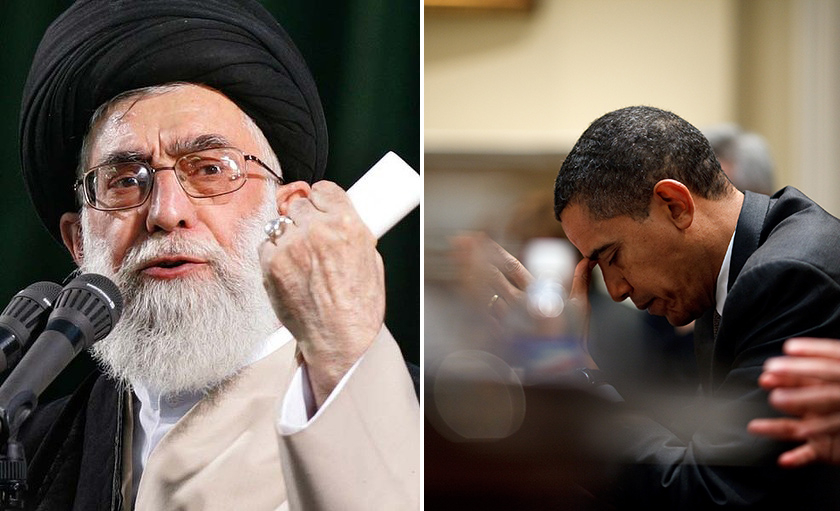Iran Breaks Nuclear Deal and UN Resolutions
Majid Rafizadeh/Gatestone Institute/December 15/16
“We will have a new ballistic missile test in the near future that will be a thorn in the eyes of our enemies.” – Iranian President Hassan Rouhani.
The range of existing Iranian ballistic missiles has grown from 500 miles to over 1,250 miles (roughly 2,000 kilometers), which can easily reach Eastern Europe, as well as countries such as Israel.
In addition, Iranian Defense Minister Brig. Gen. Hossein Dehqan said that there would be no limit for the range and amount of missiles that Iran will develop.
The nuclear agreement, known as the Joint Comprehensive Plan of Action Agreement (JCPOA) — effective, as of October 18, 2015, according to the State Department – clearly and distinctly stipulates that Iran should not undertake any ballistic missile activity “until the date eight years after the JCPOA Adoption Day or until the date on which the IAEA submits a report confirming the Broader Conclusion, whichever is earlier.”
Not only is Iran avoiding honoring this stipulation, but also Iran’s ballistic missile operations have significantly ratcheted up. More importantly, there has been no criticism at all from the Obama administration or other involved parties regarding this critical violation.
As cited by Iran’s state-owned Fars News Agency, Brig. Gen. Amir Ali Hajizadeh, Iran’s commander of the Islamic Revolutionary Guards Corps (IRGC) Aerospace Force, said in Tehran on Dec 6, 2016:
“In addition to enhancing the precision-striking power and quality of ballistic missiles, the Iranian authorities and experts have used innovative and shortcut methods to produce inexpensive missiles, and today we are witnessing an increase in production [of ballistic missiles].”
Iran is bragging about it.
In addition, Iranian Defense Minister Brig. Gen. Hossein Dehqan said that there would be no limit for the range and amount of missiles that Iran will develop. He boasted:
“90 percent of the country’s defense systems have reached an acceptable standard and enjoy competitive quality compared with the weapons of advanced countries; production of the national individual weapons and efforts to improve the quality and precision-striking power of ballistic missiles are among the defense ministry’s achievements in the defense field.”
Fars News reported on a December 6, 2016 statement from Iran’s Defense Minister:
“His remarks came as the Islamic Revolution Guards Corps (IRGC) fired 2 home-made ‘Qadr H’ ballistic missiles from the Eastern Alborz Mountains at a target in Iran’s Southeastern Makran seashore some 1400km away… The missiles were fired on the sidelines of the main stage of the IRGC drills in Central Iran and various parts of the country.”
One missile, which was launched on March 2016, had a clear message written on it that said in the Hebrew language: “Israel should be wiped off the Earth”. Fars Agency adds:
“Qadr is a 2000km-range, liquid-fuel and ballistic missile which can reach territories as far as Israel… The missile can carry different types of ‘Blast’ and ‘MRV’ [Multiple Reentry Vehicle] payloads to destroy a range of targets. The new version of Qadr H can be launched from mobile platforms or silos in different positions and can escape missile defense shields due to their radar-evading capability.”
Iran has repeatedly test-fired, long-range ballistic missiles and laser-guided surface-to-surface missiles. For example, on March 2016, Iran tested a new ballistic missile, capable of carrying multiple warheads. More recently, Iran fired a test missile with an accuracy within 25 feet, which is characterized as “zero error,” according to Brig. Gen. Ali Abdollahi, the Iranian military’s deputy chief of staff, and Iran’s semi-official Tasnim news agency.
The range of existing Iranian ballistic missiles has grown from 500 miles to over 1,250 miles (roughly 2,000 kilometers), which can easily reach Eastern Europe, as well as countries such as Israel.
According to a previous report obtained by the Associated Press, the launches are “destabilizing and provocative” and the Shahab-3 medium-range ballistic missile and Qiam-1 short-range ballistic missile fired by Iran are “inherently capable of delivering nuclear weapons.”
In addition to violating the nuclear agreement, provoking and threatening other nations, and destabilizing the region, Iran is breaching two UN Security Council Resolutions. Security Council resolution 2231 (section 3 of Annex B) “calls upon Iran not to undertake any activity related to ballistic missiles designed to be capable of delivering nuclear weapons, including launches using such ballistic missile technology.”
The second United Nations Security Council resolution, 1929, states:
“Iran shall not undertake any activity related to ballistic missiles capable of delivering nuclear weapons, including launches using ballistic missile technology, and that States shall take all necessary measures to prevent the transfer of technology or technical assistance to Iran related to such activities.”
Iran has the largest ballistic missile arsenal in the Middle East. It is also the most diversified one. No country, other than Iran, has acquired long-range ballistic missiles before obtaining nuclear weapons. Ballistic missiles can be used for offensive or defensive purposes, but sophisticated missiles are more likely developed as delivery vehicles for nuclear weapons.
These missiles have the capability of carrying multiple nuclear warheads. Iran Tasnim news agency reported:
“Defense Minister Brigadier General Hossein Dehqan praised the country’s military might…saying the Islamic Republic can mass produce ballistic missiles with any range and destructive power… In the missile sphere, Iran has been able to maximize the accuracy of projectiles, as emphasized by Leader of the Islamic Revolution Ayatollah Seyed Ali Khamenei, with reliance on the local forces, Brigadier General Amir Ali Hajizadeh said at an academic ceremony in Tehran on Tuesday.”
Iran is also is increasingly provoking other countries in the region, and has made it clear that the ballistic missiles are aimed at targeting other nations. Brig. Gen. Amir Ali Hajizadeh, said previously to FARS news agency that “Iran has built missiles that can hit targets at 2,000 Km. They are designed to hit Israel at such a distance.” He added that Islamic countries have surrounded Israel and “its [Israel’s] life is short. So it will collapse in any given war — long before a missile is even fired.”
Iran also exports these missiles to its proxies across the region. Tasnim news agency quoted General Hossein Salami as saying:
“Hezbollah has 100,000 missiles that are ready to hit Israel to liberate the occupied Palestinian territories if the Zionist regime repeats its past mistakes… today, the grounds for the annihilation and collapse of the Zionist regime are (present) more than ever.”
In addition, Gen. Salami warned Israeli leaders that if they make the “wrong move,” Israel would come under attack.
It is crucial to point out that both Iran’s so-called “moderates” and hardliners are on the same page when it comes developing ballistic missiles. When his country was unveiling a new missile, Fateh 313, President Hassan Rouhani pointed out that “we will have a new ballistic missile test in the near future that will be a thorn in the eyes of our enemies.”
The Obama administration, the international community, a major global power, or a coalition of nations need robustly to confront these provocations, threats, and violations of the nuclear deal and UN Security Council Resolutions by Iran.
**Dr. Majid Rafizadeh, political scientists and Harvard University scholar is president of the International American Council on the Middle East. He can be reached at Dr.rafizadeh@post.harvard.edu.
© 2016 Gatestone Institute. All rights reserved. The articles printed here do not necessarily reflect the views of the Editors or of Gatestone Institute. No part of the Gatestone website or any of its contents may be reproduced, copied or modified, without the prior written consent of Gatestone Institute. https://www.gatestoneinstitute.org/9584/iran-breaks-nuclear-deal





















